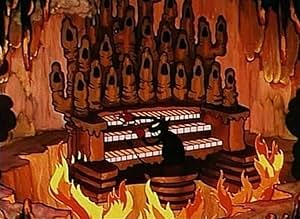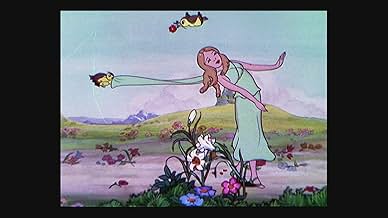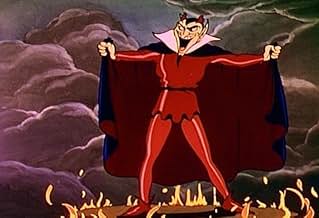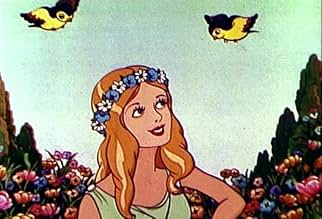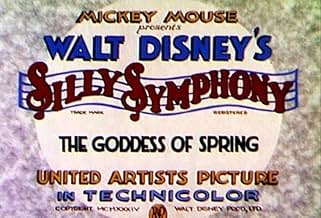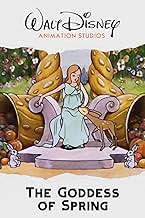VALUTAZIONE IMDb
6,6/10
1552
LA TUA VALUTAZIONE
Aggiungi una trama nella tua linguaThe lovely goddess of spring, Persephone, is kidnapped by Hades, thus bringing about the winter season.The lovely goddess of spring, Persephone, is kidnapped by Hades, thus bringing about the winter season.The lovely goddess of spring, Persephone, is kidnapped by Hades, thus bringing about the winter season.
- Regia
- Sceneggiatura
- Star
Kenny Baker
- Singing Narrator
- (voce)
- (non citato nei titoli originali)
Jessica Dragonette
- Goddess of Spring
- (voce)
- (non citato nei titoli originali)
Tudor Williams
- Pluto
- (voce)
- (non citato nei titoli originali)
Recensioni in evidenza
A Walt Disney SILLY SYMPHONY Cartoon Short.
Persephone, THE GODDESS OF SPRING, is kidnapped by Hades, the devilish god of the Underworld, leaving the earth in perpetual winter. Will the warmth & joy of Spring ever return?
A vivid, and somewhat bizarre, little film which retells the story from Greek Mythology, while incorporating both operatic & jazz traditions. The animators seem to have confused the character of Hades with that of the Biblical Satan. Years later, Walt would draw comparison between Persephone & Snow White, to illustrate how far his animators evolved in just three short years.
The SILLY SYMPHONIES, which Walt Disney produced for a ten year period beginning in 1929, are among the most fascinating of all animated series. Unlike the Mickey Mouse cartoons in which action was paramount, with the Symphonies the action was made to fit the music. There was little plot in the early Symphonies, which featured lively inanimate objects and anthropomorphic plants & animals, all moving frantically to the soundtrack. Gradually, however, the Symphonies became the school where Walt's animators learned to work with color and began to experiment with plot, characterization & photographic special effects. The pages of Fable & Fairy Tale, Myth & Mother Goose were all mined to provide story lines and even Hollywood's musicals & celebrities were effectively spoofed. It was from this rich soil that Disney's feature-length animation was to spring. In 1939, with SNOW WHITE successfully behind him and PINOCCHIO & FANTASIA on the near horizon, Walt phased out the SILLY SYMPHONIES; they had run their course & served their purpose.
Persephone, THE GODDESS OF SPRING, is kidnapped by Hades, the devilish god of the Underworld, leaving the earth in perpetual winter. Will the warmth & joy of Spring ever return?
A vivid, and somewhat bizarre, little film which retells the story from Greek Mythology, while incorporating both operatic & jazz traditions. The animators seem to have confused the character of Hades with that of the Biblical Satan. Years later, Walt would draw comparison between Persephone & Snow White, to illustrate how far his animators evolved in just three short years.
The SILLY SYMPHONIES, which Walt Disney produced for a ten year period beginning in 1929, are among the most fascinating of all animated series. Unlike the Mickey Mouse cartoons in which action was paramount, with the Symphonies the action was made to fit the music. There was little plot in the early Symphonies, which featured lively inanimate objects and anthropomorphic plants & animals, all moving frantically to the soundtrack. Gradually, however, the Symphonies became the school where Walt's animators learned to work with color and began to experiment with plot, characterization & photographic special effects. The pages of Fable & Fairy Tale, Myth & Mother Goose were all mined to provide story lines and even Hollywood's musicals & celebrities were effectively spoofed. It was from this rich soil that Disney's feature-length animation was to spring. In 1939, with SNOW WHITE successfully behind him and PINOCCHIO & FANTASIA on the near horizon, Walt phased out the SILLY SYMPHONIES; they had run their course & served their purpose.
'The Goddess of Spring (1934)' is a beautiful "Silly Symphony" from Walt Disney and director Wilfred Jackson, filmed in glorious Technicolor of which full advantage is taken. The film was produced as a trial-run for the the feature-length 'Snow White and the Seven Dwarfs (1937),' largely to experiment with the animation of humans. The progress made in the subsequent three years is startlingly apparent the heroine in this film has a pretty and graceful face, but there's very little grace in her movements. The Goddess of Spring prances around her vibrant above-ground kingdom, limbs flailing somewhat awkwardly, her gait completely unrealistic, though perhaps it was the animators' intention to have her slightly floating above the ground, as though her loveliness affords her the weightless waltz of an angel. Suddenly, the sky grows dark and the ground erupts into fire, signalling the arrival of the wicked Hades, who kidnaps the beautiful Goddess to be queen of his underground kingdom. With the fair maiden's departure, the lands are plunged into a cold, bitter winter.
This Silly Symphony was loosely based upon the Ancient Greek mythology of Persephone and Hades, and so the tone of cartoon is chiefly that of an epic opera a bit like 'What's Opera, Doc? (1957),' if you need an easy comparison. The warm, nostalgic singing voice at the film's beginning gives way to the deep, operatic snarl of Hades as he comes to confiscate his future queen. Interestingly, when the pair arrive in the fire-wreathed corridors of Hell, the general atmosphere is that of a jazz club, with disconcertingly upbeat music, and dancing audiences who chant "Hidey Hades." This interpretation of down-below is very different from Ub Iwerks' version five years earlier in 'Hell's Bells (1929),' which was darker and more archaic. The most touching contrast of all is that between the above-ground kingdom's spring and winter, as the bright sunlight swiftly disappears to unleash a miserable snap of cold and bitter winds; the dwarf inhabitants shiver in the snow, and even Bambi makes a brief appearance
This Silly Symphony was loosely based upon the Ancient Greek mythology of Persephone and Hades, and so the tone of cartoon is chiefly that of an epic opera a bit like 'What's Opera, Doc? (1957),' if you need an easy comparison. The warm, nostalgic singing voice at the film's beginning gives way to the deep, operatic snarl of Hades as he comes to confiscate his future queen. Interestingly, when the pair arrive in the fire-wreathed corridors of Hell, the general atmosphere is that of a jazz club, with disconcertingly upbeat music, and dancing audiences who chant "Hidey Hades." This interpretation of down-below is very different from Ub Iwerks' version five years earlier in 'Hell's Bells (1929),' which was darker and more archaic. The most touching contrast of all is that between the above-ground kingdom's spring and winter, as the bright sunlight swiftly disappears to unleash a miserable snap of cold and bitter winds; the dwarf inhabitants shiver in the snow, and even Bambi makes a brief appearance
For some reason the animation in this cartoon doesn't make it appear to be a Disney Silly Symphony. Still, it's a pretty good cartoon that tells the story of the goddess Persephone, kidnapped by Hades, causing Spring to prematurely turn into Winter.
It's also a rather exciting cartoon short, as well, and a clever retelling of the Greek mythology. The narration and dialog were all beautifully sung and the characters were delightful to watch.
Grade B
It's also a rather exciting cartoon short, as well, and a clever retelling of the Greek mythology. The narration and dialog were all beautifully sung and the characters were delightful to watch.
Grade B
As the Snow White Platinum DVD notes, The Goddess of Spring served mostly as practice for the Disney animators on how to properly animate humans for Snow White & the Seven Dwarfs. Not only did they improve on animating humans, I thought they also greatly improved on drawing backgrounds, animals, and the dwarf-like creatures that appeared in The Goddess of Spring. While The Goddess of Spring is an animated short with a much smaller budget, the difference between the dwarfs in this cartoon and Snow White are as different as night and day. The dwarfs in Goddess of Spring were all drawn the same with no unique personalities, whereas Snow White's dwarfs are all unique in both appearance and personality.
I've also read that people were impressed with how well the hell sequences were drawn in Goddess of Spring. I have to admit that I wasn't really impressed when I saw it. I thought the sequences were too bland and a little too bright for a depiction of hell. I was actually more impressed with the hell sequences drawn in 1929's Hell's Bells, one of the first, rare Silly Symphonies drawn by Ub Iwerks.
However, I will say that I did somewhat enjoy the story of Goddess of Spring, which uses mythology to explain why we don't have everlasting spring. The opera style was kind of corny though. I just didn't get the sense that Disney animators concentrated too much on this short, but rather just as practice for Snow White. Nevertheless, I guess Goddess of Spring fulfilled its mission, because Snow White is one of the greatest, most landmark films in the history of cinema.
My IMDb Rating: 5/10
I've also read that people were impressed with how well the hell sequences were drawn in Goddess of Spring. I have to admit that I wasn't really impressed when I saw it. I thought the sequences were too bland and a little too bright for a depiction of hell. I was actually more impressed with the hell sequences drawn in 1929's Hell's Bells, one of the first, rare Silly Symphonies drawn by Ub Iwerks.
However, I will say that I did somewhat enjoy the story of Goddess of Spring, which uses mythology to explain why we don't have everlasting spring. The opera style was kind of corny though. I just didn't get the sense that Disney animators concentrated too much on this short, but rather just as practice for Snow White. Nevertheless, I guess Goddess of Spring fulfilled its mission, because Snow White is one of the greatest, most landmark films in the history of cinema.
My IMDb Rating: 5/10
This entry in the Silly Symphonies adapts the story of Persephone (Proserpina in Latin). "The Goddess of Spring" depicts the title character in an idealistic setting until Hades (Pluto in Latin) kidnaps her. Since she can't be happy in Hell, they have to reach a settlement.
Obviously this is a loose adaptation. As in Disney's "Hercules", Hades gets depicted as a rendering of Satan; in Greek mythology, the underworld had no relation to the modern understanding of Hell.
It's an okay cartoon. I've always been more partial to Warner Bros.'s cartoons, since they had an irreverent side (in contrast to Disney's "nice" cartoons). Jessica Dragonette (the goddess) also voiced Princess Glory in Fleischer Studios' "Gulliver's Travels". Kenny Baker (the narrator) is not to be confused with the actor who played R2D2.
Obviously this is a loose adaptation. As in Disney's "Hercules", Hades gets depicted as a rendering of Satan; in Greek mythology, the underworld had no relation to the modern understanding of Hell.
It's an okay cartoon. I've always been more partial to Warner Bros.'s cartoons, since they had an irreverent side (in contrast to Disney's "nice" cartoons). Jessica Dragonette (the goddess) also voiced Princess Glory in Fleischer Studios' "Gulliver's Travels". Kenny Baker (the narrator) is not to be confused with the actor who played R2D2.
Lo sapevi?
- QuizWalt Disney and his animators used this short as a test to see if they could create realistic animation, a style they would later perfect in Biancaneve e i sette nani (1937).
I più visti
Accedi per valutare e creare un elenco di titoli salvati per ottenere consigli personalizzati
Dettagli
- Data di uscita
- Paese di origine
- Sito ufficiale
- Lingua
- Celebre anche come
- A Greek Myth
- Azienda produttrice
- Vedi altri crediti dell’azienda su IMDbPro
- Tempo di esecuzione10 minuti
- Proporzioni
- 1.37 : 1
Contribuisci a questa pagina
Suggerisci una modifica o aggiungi i contenuti mancanti

Divario superiore
By what name was La dea della primavera (1934) officially released in Canada in English?
Rispondi
